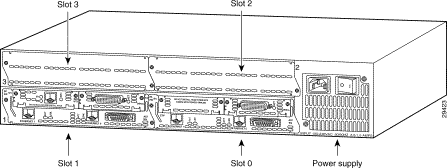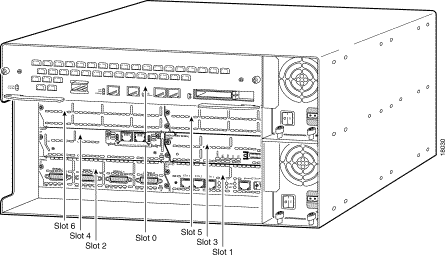How Async Lines are Numbered in Cisco 3600 Series Routers
Available Languages
Contents
Introduction
This document discusses how async lines are numbered in Cisco 3600 Series Routers.
Prerequisites
Requirements
There are no specific requirements for this document.
Components Used
The information provided in this document is not restricted to any specific software version, and is based on the hardware platform below:
-
Cisco 3600 Series Routers
The information presented in this document was created from devices in a specific lab environment. All of the devices used in this document started with a cleared (default) configuration. If you are working in a live network, ensure that you understand the potential impact of any command before using it.
Conventions
For more information on document conventions, see the Cisco Technical Tips Conventions.
Async Line Numbering
Async lines are not numbered in a linear fashion on the Cisco 3600 platform. Due to the modular design of these routers, there are fixed line ranges for each slot and each slot is allocated 32 line numbers. This means that the configuration does not change when you add or remove async lines from other slots. The following table shows the reserved line numbering per slot on Cisco 3600 router platforms.
| Slot | Platform | Reserved line numbering |
|---|---|---|
| 0 | 3620/3640 | 1 - 32 |
| 1 | 3620/3640/3660 | 33 - 64 |
| 2 | 3640/3660 | 65 - 96 |
| 3 | 3640/3660 | 97 - 128 |
| 4 | 3660 | 129 - 160 |
| 5 | 3660 | 161 - 192 |
| 6 | 3660 | 193 - 224 |
Note: Slot 0 is reserved for the motherboard on the Cisco 3660. This slot cannot hold any network modules; therefore, line numbering on the Cisco 3660 starts at 33, corresponding to the numbering associated with slot 1 for the whole Cisco 3600 family. For sample configurations refer to the 3600 Product Support Page.
The following diagrams illustrate the positions of the various slots on Cisco 3620, 3640, and 3660 routers:
Cisco 3620

Cisco 3640

Cisco 3660

Modules with async ports have different densities (for example, 4, 16, 24, and so on). It is possible to have a combination of network modules with several line ranges that have gaps in their numbering. If the same functionality is desired for all async lines, you have to replicate the configuration in all line ranges. Be careful when using line range commands such as the group-range command under Group-Async interfaces. This command does not allow discontiguous range configuration; therefore, you need separate Group-Async interfaces so that each of them references a separate line range.
Following is a sample hardware configuration:
Chassis: Cisco 3660 Slot 1: NM-4A/S (4 Port Sync/Async Serial Network Module) Slot 2: NM-4A/S (4 Port Sync/Async Serial Network Module) Slot 3: Empty Slot 4: NM-32A (32 Port Async Network Module) Slot 5: Empty Slot 6: Empty
After the router boots up, here are the default line ranges:
c3660#show running-config | begin line con 0 ...... line con 0 transport input none line 33 36 line 65 68 line 129 160 line aux 0 line vty 0 4 login ! end
The modules are rearranged in this configuration:
Slot 1: NM-32A (32 Port Async Network Module) Slot 2: NM-4A/S (4 Port Sync/Async Serial Network Module) Slot 3: Empty Slot 4: Empty Slot 5: Empty Slot 6: NM-4A/S (4 Port Sync/Async Serial Network Module)
When the modules are rearranged, these are the default line ranges:
c3660#show running-config | begin line con 0 line con 0 transport input none line 33 68 line 193 196 line aux 0 line vty 0 4 login ! end
Note: In this configuration there are only two line ranges, since the NM-32A module in slot 1 has a 32-port density that leaves no gaps in line numbering.
Related Information
Revision History
| Revision | Publish Date | Comments |
|---|---|---|
1.0 |
09-Sep-2005 |
Initial Release |
Contact Cisco
- Open a Support Case

- (Requires a Cisco Service Contract)
 Feedback
Feedback